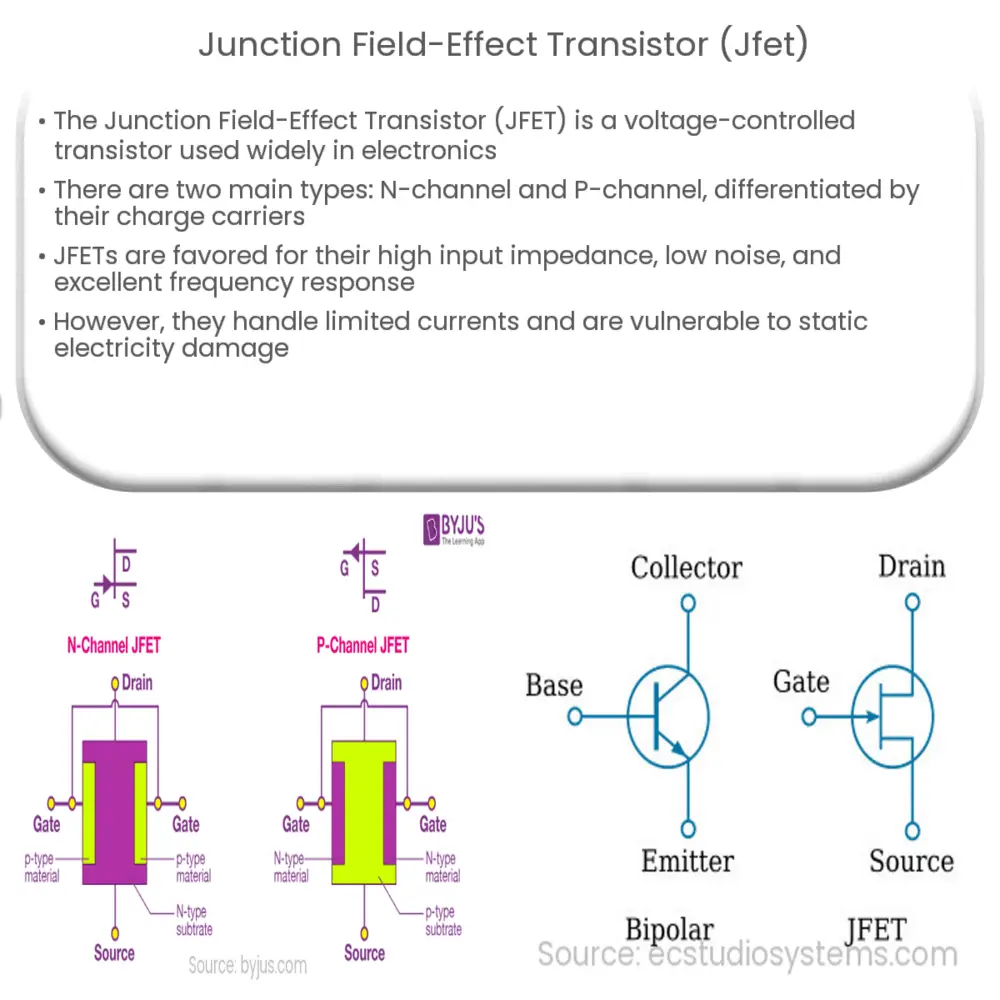Explore the Junction Field-Effect Transistor (JFET): its structure, operation, characteristics, applications, and limitations in modern electronics.

Introduction to Junction Field-Effect Transistor (JFET)
The Junction Field-Effect Transistor, often abbreviated as JFET, is a type of transistor used in many electronic applications due to its unique characteristics. These devices are voltage-controlled transistors, meaning the current flowing through the device is controlled by an applied voltage.
Structure and Operation of JFET
The JFET is made up of a channel of semiconductor material through which the current flows. This channel is sandwiched between two pn junctions. There are two main types of JFETs – the N-channel JFET and the P-channel JFET, depending on the type of charge carriers that flow through the channel.
- N-channel JFET: In this type of JFET, the charge carriers are electrons. The flow of current is controlled by a voltage applied to the gate terminal. When the voltage is negative or zero, the current flow is maximum. However, as the voltage becomes more positive, the current decreases.
- P-channel JFET: The P-channel JFET operates in a similar way to the N-channel JFET, but the charge carriers are holes rather than electrons. Here, the current flow is maximum when the gate voltage is positive or zero, and it decreases as the voltage becomes more negative.
Characteristics of JFET
JFETs have a number of characteristics that make them useful in various applications. These include:
- High Input Impedance: JFETs have a very high input impedance, typically in the order of 1010 ohms. This makes them ideal for applications where a high degree of isolation is required between the input and output.
- Low Noise: They generate very little noise, making them ideal for sensitive electronic equipment such as pre-amplifiers and instrumentation amplifiers.
- Excellent Frequency Response: JFETs have an excellent high-frequency response, making them well-suited for RF applications.
Despite these advantages, JFETs do have some limitations. For instance, they can only handle relatively small currents and they are more susceptible to damage from static electricity compared to other types of transistors.
Applications of JFET
JFETs are widely used in a variety of applications due to their unique characteristics. Here are a few notable examples:
- Amplifiers: The high input impedance and low noise characteristics of JFETs make them ideal for use in various types of amplifiers, including audio amplifiers, RF amplifiers, and instrumentation amplifiers.
- Switches: JFETs can also be used as electronic switches. Because they are voltage-controlled devices, they can be used to switch high-frequency signals without inducing much noise.
- Buffer Circuits: Due to their high input impedance, JFETs are often used in buffer circuits, where they can effectively isolate different stages of an electronic system.
- Oscillators: JFETs can also be used in the construction of oscillators due to their excellent frequency response.
Conclusion
In conclusion, the Junction Field-Effect Transistor (JFET) is a critical component in many electronic devices. Its high input impedance, low noise characteristics, and excellent frequency response make it well-suited for a variety of applications, such as amplifiers, switches, buffer circuits, and oscillators. However, like any electronic component, it’s not without its limitations. They can handle only relatively small currents, and they are more susceptible to damage from static electricity compared to other types of transistors. Despite these drawbacks, the JFET remains a staple in modern electronics, underscoring the importance of understanding its operation and characteristics for anyone involved in electronics design or repair.

